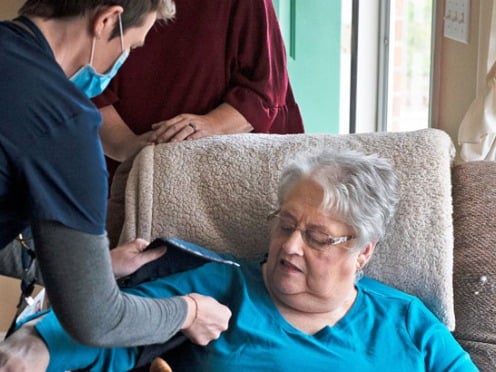
A McKesson employee and cancer survivor’s story of resilience and the power of empathy.

Guided by our values, we are an impact-driven organization that improves care in every setting – one product, one partner, one patient at a time.
Through our core commitments, we are leveraging our scale for the greater good, such as serving the needs of our stakeholders, donating back to our communities, protecting our planet, working with policymakers, and more.
Every year, we publish updates to our commitments through our Impact Report.
Download Our Impact ReportOur businesses bring together leading technologies, innovative solutions and hands-on expertise to support the entire healthcare ecosystem.
We distribute pharmaceuticals and medical supplies to healthcare settings across North America, from pharmacies and hospitals to doctors’ offices and clinics.
We help to ensure the financial wellbeing of pharmacies and health systems and support a stable work environment for their employees.
We provide research, insights, technologies and other support to help address challenges in cancer and specialty care.
We provide a suite of solutions designed to address access, affordability and adherence challenges by bridging the gaps between biopharma companies, pharmacies, providers, and payers to help patients get on and stay on their medications.
We offer solutions that enable employers, payers, health-plan brokers and government agencies to provide lower-cost options for prescription medications and therapies.
We help to ensure the financial wellbeing of pharmacies and health systems and support a stable work environment for their employees.
Every year, we publish updates to our commitments through our Impact Report.
Download Our Impact ReportMcKesson Medical-Surgical makes it easy to provide excellent, convenient home healthcare at a lower cost.

Spurred in part by the COVID pandemic, the home healthcare market is accelerating. Forecasting experts predict that in the next three years, up to $265 billion worth of care for medicare fee-for-service and medicare advantage beneficiaries could shift from traditional healthcare facilities to the home – and that’s without compromising the quality of treatment. private insurance companies are also expanding their coverage of home-based care.
As a leading distributor of medical supplies, McKesson Medical-Surgical is well-positioned to furnish home healthcare agencies, home medical equipment companies, home infusion providers, and others providing acute and primary care services in the home with the resources they need to thrive in this growing field. In addition to providing the actual supplies – everything from infusion pumps and catheters to oxygen tanks and hospital-style beds – the company also offers maintenance and repair services, as well as clinical education services.
“We can be a one-stop-shop for these home healthcare providers. otherwise, they would need to use a few different distributors, which can be logistically challenging as well as more costly,” says Kelly Van Vliet, senior segment marketing manager for the home infusion customer segment of McKesson Medical-Surgical.
Of course, not everyone who gets healthcare at home is acutely ill. Home healthcare agencies routinely care for people who take medications via infusion for chronic conditions like rheumatoid arthritis and inflammatory bowel disease, as well as those who need wound care. babies and children needing enteral nutrition (tube feeding) because of a chronic condition or growth delay may also benefit. physical therapy, occupational therapy, and even speech therapy can also be provided at a patient’s home.
The option to receive such services at home is far less taxing than having to travel to a healthcare facility, especially for those who have physical mobility issues, live in a rural area, or lack access to reliable transportation.
“Imagine an 80-year-old person in a wheelchair having to be lifted in and out of a car and driven by caregiver to a medical center,” says Patti Baicy, RN, clinical team director for McKesson Medical-Surgical.
That’s not to say that all homecare patients are elderly: most home care patients getting infusions, for instance, are age 15-64, according to the national home infusion foundation (nhif) 2020 infusion industry trends report.
McKesson has an advantage over many competitors for several reasons, including its long history in this space, as well as its relationship with partners providing electronic medical record services used by homecare nurses. other unique features include a patient home delivery service.
“We can a send a box of supplies directly from our warehouse to a patient’s home, and a home health nurse or the patient can find out what has been delivered and confirm they have everything they need,” Baicy says.
In addition to providing equipment and supplies, McKesson Medical-Surgical also has programs to support providers that cater to taking care of people in their homes with clinical education.
“We can help with the selection of supplies and equipment, as well as formulary development,” Baicy says. “our goal is to supplement their product knowledge and help them select the best products for the best patient outcomes.”
Interest in all these services has grown as patients and payers are becoming increasingly supportive of home-based care – and for good reason.
Although the pandemic has contributed to an uptick in home-based healthcare, it’s hardly the only factor. Getting healthcare services at home tends to be more comfortable, more convenient, and less costly compared to healthcare that’s obtained at a hospital, rehab center, or outpatient medical facility.
“One of the main benefits is that the patient gets to recover from an acute illness or receive ongoing care for a chronic condition in their own home, where the surroundings are familiar and it’s easier for family to support them,” Baicy explains.
In the past, home-based care might have been perceived by some as less effective than care delivered in a traditional medical setting, but that’s no longer the assumption, adds Van Vliet. Both patients and providers have come to understand that, in many cases, extremely high-quality healthcare can be administered in a home setting. indeed, research has shown that people recovering from total joint replacement surgery at home fare just as well as those who recuperate in a hospital or rehab center.
Even seriously ill people may benefit. a 2020 study, published in the annals of internal medicine, found that people who required “hospital-level” care had a 70% lower rate of hospital readmission if they were treated at home by a visiting nurse or physician instead of in an actual hospital.
For providers, payers and patients of any age who have high copays or major out-of-pocket costs, the financial rewards are also significant: the above-mentioned study found that acute care costs about 40% less when it’s provided at home versus in a hospital, while other research has found that savings might exceed 50%.
“It’s a less expensive model, especially when the other option is to have someone stay at a hospital or rehab center,” Baicy says. “You don’t have a physical building with maintenance and housekeeping to support, nor do you have to provide meals or round-the-clock care in many instances.”
While reducing costs is certainly top of mind, ultimately, it’s all about streamlining care while keeping patients as comfortable and as healthy as possible.
“Most patients prefer to get care in their own homes, which helps drive better patient outcomes,” Van Vliet says.

A McKesson employee and cancer survivor’s story of resilience and the power of empathy.

Discover how McKesson Amplify is strengthening the voice of pharmacy professionals nationwide by awarding funding to every eligible state pharmacy association across all 50 states.

Top insights from the Endpoints at ASCO McKesson leadership panel

Insights and Takeaways for The Next Chapter in Specialty Medicine from Asembia AXS25

Enhancing patient access and engagement in clinical trials.

Learn how InspiroGene is helping deliver revolutionary cell and gene therapies to patients in need.

Insights from the 2025 CoverMyMeds Medication Access Report, From Barriers to Bridges

For two years in a row, McKesson has partnered with customers and industry partners to bring health education and awareness of resources to members of the Navajo community.

Learn more about RxOwnership, McKesson’s strategic consultants who help independent pharmacy owners navigate challenges, optimize operations and achieve financial health.

During the recent STAT @ ASH event in San Diego, panelists explored the role of community oncology in advancing precision medicine for cancer care.